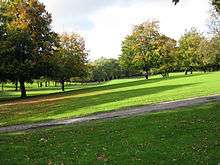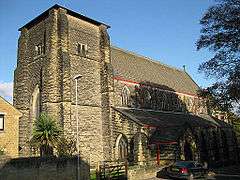Potternewton

Potternewton is a suburb and parish of north-east Leeds, West Yorkshire, England, between Chapeltown and Chapel Allerton (in whose ward the area falls). Potternewton is between Scott Hall Road on the west and Roundhay Road on the east, with Harehills Lane on the north. The main thoroughfare is Chapeltown Road, and Potternewton is often taken to be part of the area referred to as Chapeltown. On older maps Potternewton included the Chapeltown and Scott Hall areas and parts of Harehills.

Potternewton is an historic village and most maps prioritise the name Potternewton over Chapeltown, but most residents of Leeds today refer to the area as Chapeltown so the names are somewhat interchangeable.
History
The Earl of Mexborough and Earl Cowper had released parts of their estates by the 1700s and by the early 19th century a number of mansions, some with extensive grounds, had been established around Potternewton and Chapeltown roads. Potternewton Park Mansion, Newton Lodge, Scott Hall and Potternewton Hall are typical examples.
In 1870, the Potternewton township, covering 1,667 acres about two miles north of Leeds, comprised the villages of New Leeds and part of Buslingthorpe, and the hamlets of Gipton, Harehills, and Squire-Pastures. Part of its name is from supposedly Roman, "very ancient pottery", found in the vicinity. Coal was mined and stone was quarried. Over time the manor belonged to the Mauleverers, the Scotts of Scott Hall, and the Hardwicks and in 1870 belonged to the Earl of Mexborough.[1]
Potternewton Hall
_and_her_cousin_Baroness_von_Schunck_(nee_Kate_Lupton).jpg)
Potternewton Hall was a country house built by the Barker family c. 1720. In the 1830s it was the residence of Darnton Lupton, whose brother Arthur (1809–1889) had acquired the adjacent Newton Hall and its surrounding parkland in the 1840s. Darnton's brother Francis lived at the hall from 1847, becoming the owner of the Potternewton Hall Estate by 1860. Francis had married in 1847, and raised his family at the hall until the early 1860s. In 1870, Francis and Darnton purchased the Newton Hall Estate from their brother Arthur. By 1880, a number of substantial buildings had been erected on the Lupton's land, including St Martin's Church. By the outbreak of the Second World War Newton Hall and Potternewton Hall had been demolished and replaced by the city's largest private housing estate.[2][3][4][5][6][7][8]
The great grandmother of Catherine, Duchess of Cambridge, Olive Middleton (née Lupton), grew up at Rockland in Potternewton. Her father, politician Francis Martineau Lupton, developed the estate, including a shopping parade built in 1891 on Chapeltown Road.[9][10][4]
Potternewton Park Mansion and park

Harehills Grove, a country house, was built around 1817 for the woollen merchant James Brown. The Jowitt family owned it in 1861 and they later sold the 750 acre estate and back-to-back terraced houses were built on it. The house and its 30 acre park were bought by the Leeds Corporation to create Potternewton Park in 1900. By 1906 the house had been renamed Potternewton Mansion and was opened to the public in 1906. After 1929 the house was used for educational purposes.[11]
The Leeds Carnival procession starts and finishes at Potternewton Park.
21st century
Transport Direct uses the names Potternewton and Chapeltown when for separate areas. Potternewton is the small area around the north of Scott Hall Road around the Scott Hall Road/Potternewton Lane roundabout as most of the area is classified today as Chapeltown. WYMetro and Transport Direct also identify the area as being in this location. Potternewton Lane is served by bus service 7.
Millfield Primary School, formerly known as Potternewton Primary, is located on Potternewton Mount.
St Martin's Church

St Martin's Church, the Anglican parish church, is off Chapeltown Road. It was built in 1879–81 on land owned by the Lupton family.[9][12] The formation of the parish was the result of a meeting held at the Leeds Church Institute in April 1876, presided over by the Vicar of Leeds, Dr Gott. Those present included members of the Lupton family, W.L. Jackson, the future MP, Lord Allerton. The site for St Martin's had been confirmed in June 1876. The church was consecrated in 1881 for Potternewton parish. It was designed by Adams & Kelly of Leeds[13] and built of stone from local quarries.
The original design had a tall steeple, but lack of funds prevented its construction. Francis Ashford Lupton married Dorothy Winifred Davison at the church on 13 August 1914. His profession was recorded as "woollen manufacturer". St Martin's Church now has a mainly West Indian congregation.[14][15][16][17][18]
References
- ↑ "Potter Newton West Riding". Vision of Britain. Retrieved 5 August 2017.
- ↑ Laycock, Mike (17 March 2015). "Duchess of Cambridge's links with stately home near York revealed". The Press. Retrieved 19 March 2015.
- ↑ "Potternewton Hall, Potternewton Lane". Leodis – A photographic History of Leeds. Leeds City Council. Retrieved 29 August 2014.
- 1 2 "Chapeltown Conservation Area Appraisal" (PDF). Leeds City Council. Retrieved 20 September 2017.
- ↑ "Potternewton, entrance gates". Leodis – A photographic History of Leeds. Leeds City Council. Retrieved 20 September 2017.
- ↑ "Potternewton Hall, Potternewton Lane". Leodis – A photographic history of Leeds. Leeds City Council. Retrieved 29 August 2014.
- ↑ "NEWTON HALL ESTATE. POTTER NEWTON". Yorkshire Post and Leeds Intelligencer. West Yorkshire, England. 31 July 1866. Retrieved 13 August 2017.
- ↑ "Sale – The Newton Hall Estate – Containing about 50 acres". Leeds Intelligencer. West Yorkshire, England. 16 June 1866. Retrieved 20 September 2017.
....comprising about 50 acres, consists of the park, the farmstead, and the meadow fields, all in a ring fence front of the house: closely adjoining a Farm, of about 10 acres, with a good farm house, stables, and cottages: a small field of about one acre, called...(also,...Leeds Intelligencer West Yorkshire, England – 21st January 1860 – PRELIMINARY ADVERTISEMENT. POTTERNEWTON HALL ESTATE.— This valuable Estate, consisting of Potternewton Hall, and about 47 Acres of Land, lying in elevated....)
- 1 2 Historic England. "Former lodge to Newton Hall with gate piers and flanking wall (1255604)". National Heritage List for England. Retrieved 27 December 2015.
- ↑ "Rockland; home of Francis Martineau Lupton and daughter Olive Middleton". Leodis – A photographic archive of Leeds. UK Gov. Leeds City Council. Retrieved 19 March 2015.
- ↑ "Potternewton Park Mansion, Harehills Lane". Leodis – A photographic history of Leeds. UK Gov Leeds City Council. Retrieved 29 August 2014.
- ↑ Conservation Area Appraisal, Chapeltown. "Chapeltown Conservation Area Appraisal" (PDF). UK GOV. Leeds City Council. Archived from the original (PDF) on 3 September 2014. Retrieved 29 August 2013.
- ↑ "St. Martin's Church". Leodis – a photographic archive of Leeds. Retrieved 1 March 2014.
- ↑ "History". St Martin's Church, Leeds. Retrieved 1 March 2014.
- ↑ "St Martin's Church, Chapeltown Road". Leodis – a photographic archive of Leeds. Retrieved 8 March 2014.
- ↑ Broadbent, Helen. "Church Archives, St Martins Church". St Martins Church, Potternewton. Retrieved 17 September 2014.
- ↑ Donaldson, S. "1914 –1918 War Dead Commemorated at Roundhay St John – Francis Ashford Lupton 1886–1917" (PDF): 58. Retrieved 31 May 2018.
- ↑ Reed, M. "House and Heritage – Potternewton Hall". houseandheritage.org. Retrieved 31 May 2018.
External links
- The ancient parish of Leeds: historical and genealogical information at GENUKI (Potternewton was in this parish).